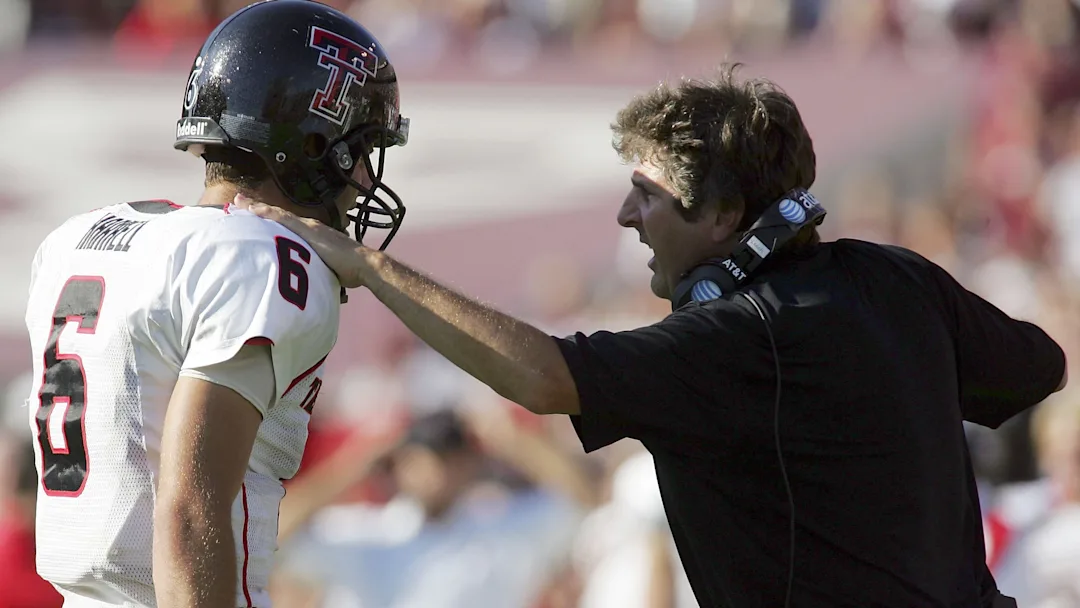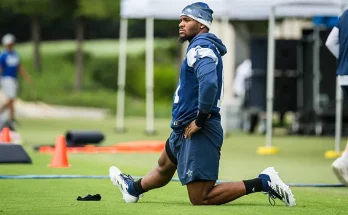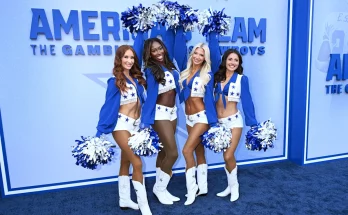Graham Harrell’s first season as a starting quarterback for Texas Tech was nothing short of jaw-dropping, marking the beginning of a record-breaking career that reshaped the identity of Red Raiders football and solidified his place in college football history. In 2006, under the guidance of head coach Mike Leach and the revolutionary Air Raid offense, Harrell lit up defenses across the Big 12 Conference, unleashing an aerial assault that left fans thrilled, opponents gasping, and scoreboards smoking.
When Harrell took over the reins of the Red Raiders offense, the expectations were high—but what unfolded during that season went beyond anyone’s wildest predictions. Texas Tech had always been known for its pass-happy offense under Leach, but Harrell added a new level of precision and intensity. In his very first season as the full-time starter, the Ennis, Texas native exploded for 4,555 passing yards and 38 touchdown passes, numbers that rivaled those of seasoned veterans. It was a breakout season that not only put him on the national radar but also set a new standard for quarterback excellence in Lubbock.
Harrell’s accuracy and poise were apparent from the opening kickoff of the 2006 campaign. He had a lightning-quick release, a sharp football IQ, and the ability to read defenses like a seasoned pro. What separated him from many quarterbacks in the country wasn’t just raw talent—it was his mastery of the system and his unwavering confidence in pushing the ball downfield. Week after week, Harrell delivered laser-precise throws to a stable of talented receivers, with junior Jarrett Hicks and sophomore Robert Johnson emerging as frequent beneficiaries of his elite passing touch.
The statistics were staggering. By the time the season concluded, Harrell had completed 412 of 617 passes, good for a 66.8% completion rate. His 4,555 passing yards ranked him second nationally, only trailing Hawaii’s Colt Brennan, who was playing in a similarly high-octane system. Harrell’s 38 touchdown passes ranked him third in the country and first in the Big 12. Those numbers were not just impressive—they were historic. For comparison, those totals would have been considered stellar in the NFL, let alone in college football, where he was still developing.
But Harrell’s contributions went beyond just the stat sheet. His leadership was infectious. Despite being a relatively young player on the field, he displayed a veteran-like command of the offense. His presence in the huddle was calming, and his ability to drive the team down the field in critical moments showed maturity beyond his years. He routinely orchestrated comeback efforts and fourth-quarter drives that kept the Red Raiders competitive, even in hostile environments.
One of the defining moments of Harrell’s 2006 season came in a dramatic game against Texas A&M. Facing a tough Aggies defense and playing under the intense pressure of a rivalry game, Harrell showcased his mental toughness and arm strength. He threw for 392 yards and five touchdowns in a thrilling 31-27 victory that sent shockwaves throughout the Big 12. That performance, along with others, helped him earn first-team All-Big 12 honors and solidified his status as one of the best quarterbacks in the country.
Another highlight came in a wild shootout against Baylor, where Harrell threw for 433 yards and four touchdowns, leading the Red Raiders to a 55-21 demolition of their conference rival. His ability to shred defenses with surgical precision was on full display, and it became evident that this wasn’t just a one-season wonder—Harrell was building something special at Texas Tech.
What made his 2006 campaign even more remarkable was that it was just the beginning. Most quarterbacks use their first season as a starter to grow and adapt, but Harrell seemed to arrive fully formed. He was fearless in the pocket, displayed pinpoint accuracy even under duress, and had a preternatural ability to extend plays. His chemistry with his receivers—many of whom would go on to have NFL careers—was already elite.
Much of Harrell’s success can be attributed to the Air Raid system, which emphasized quick decision-making, spreading the field, and taking advantage of mismatches. But even within that quarterback-friendly scheme, Harrell distinguished himself. He wasn’t just executing plays—he was elevating them. His timing, footwork, and instincts allowed him to exploit coverages and thread the ball into tight windows. His mechanics were textbook, and his deep ball had both touch and velocity.
Defensive coordinators across the Big 12 were left scrambling to figure out how to contain the Red Raiders’ offense, often resorting to exotic coverages and relentless blitzing. But Harrell thrived under pressure, using his quick release to nullify pass rushes and his vision to find the open man. His decision-making was remarkably sharp for a first-year starter, with a touchdown-to-interception ratio that reflected both aggressiveness and discipline.
National media began to take notice. Harrell’s name was mentioned alongside the likes of Brady Quinn, Troy Smith, and Colt Brennan when discussing the nation’s top signal-callers. Analysts marveled at how smoothly he transitioned into the starting role and predicted that he would go on to shatter records—which, in the seasons that followed, he indeed did. But even in 2006, it was clear that Harrell was not just another quarterback passing through the system—he was a transcendent talent.
His performances helped lead Texas Tech to a 7-6 overall record and a berth in the Insight Bowl, where they faced off against Minnesota in one of the most unforgettable comebacks in college football history. Down 38-7 in the third quarter, Harrell led a furious rally, throwing for 445 yards and two touchdowns as the Red Raiders stormed back to win 44-41 in overtime. It was a signature game that encapsulated everything Harrell represented: resilience, brilliance, and the refusal to quit.
That Insight Bowl win not only capped a phenomenal season but also served as a launching pad for the next two years, during which Harrell would continue to dominate the college football landscape. But 2006 was the year that announced his arrival. It was the year that transformed Texas Tech from a fringe Big 12 contender to a legitimate national offensive powerhouse.
Graham Harrell’s first season as a starter didn’t just break records—it broke expectations. It redefined what was possible in a pass-first offense and showcased the future of quarterback play in the spread era. It was a season marked by video game-like numbers, thrilling finishes, and moments that etched themselves into Red Raiders lore. More importantly, it laid the foundation for Harrell’s legendary career at Texas Tech, where he would go on to become one of the most statistically prolific quarterbacks in NCAA history.
In retrospect, it’s clear that 2006 was not only a breakout year—it was a revelation. Graham Harrell took the reins of a complex, high-speed offense and mastered it in real time. He turned potential into production and hype into history. And for fans in Lubbock and beyond, it was the beginning of something unforgettable.



